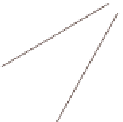Geology Reference
In-Depth Information
Depth
m
ft
Velocity
Caliper
Fractur
e
s
Facies
305
1000
1000
(305 m)
Unfractured
Fractured
Background
Interruption
1100
1100
(335 m)
Sequence
d
1200
1200
(366 m)
SSB-D
1300
1300
(396 m)
Sequence
e
(427 m)
1400
1400
SSB-E
1500
1500
(457 m)
Sequence
f
1600
1600
(488 m)
518
1700
1700
(518 m)
4
5
6
7
8
2000
3000
4000
5000
6000
(10.2
12.8
15.3
17.9
20.4 cm)
Velocity (m s
−
1
)
Caliper (inches)
Fig. 7.
Sonic velocity and caliper logs over the fracture interval. The fractures show greater velocity than the adjacent
hemipelagic sediments, a result of greater cementation. Likewise, the caliper log refl ects a smaller diameter borehole in the
skeletal interruptions relative to the less cemented hemipelagic intervals.
example suggests that early cementation (in this
case the reef margin) can fracture relatively early
under load-related infl uences. In the case of Clino,
the affect of down-to-the-basin compaction is hard
to assess (in core), but perhaps the preferential
fracture dip direction to the basin (west) (Fig. 8)
might be explained by this infl uence.
Attitude of fracture surfaces
Bahamas Drilling Project
Core CLINO
Palaeo-margin
strike orientation?
Fracture
dip angle
Fracture
dip direction
N
0
30
330
90
70
50
5
60
300
0
3
30
1
10
CONCLUSIONS
90 E
W 270
Studies of fracturing within prograding carbon-
ates are relatively rare. In one example, Saller
(1996) and others describe fractures within the
reefal facies of the Capitan that have dip direc-
tions normal to the depositional strike of the
platform margin. The Capitan fractures range
between 75° and 85° and were interpreted to have
formed because of extension during down-to-
the-basin differential compaction. The Bahamas
fractures may have also experienced some of the
same differential compaction, but fracturing was
probably driven largely by the loading effects
of the overlying, rapidly emplaced prograded
120
240
150
210
180
S
Fig. 8.
Attitude of the fracture surfaces (dip angle from
the horizontal) in Clino as determined by palaeomagnetic
orientation. The conjugate fractures refl ect an orientation
perpendicular to the platform margin, with the majority of
the fractures dipping seaward.
























































































































































